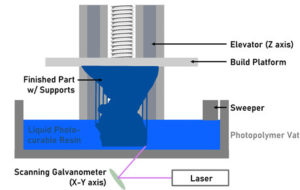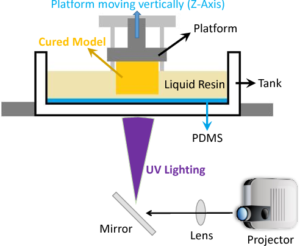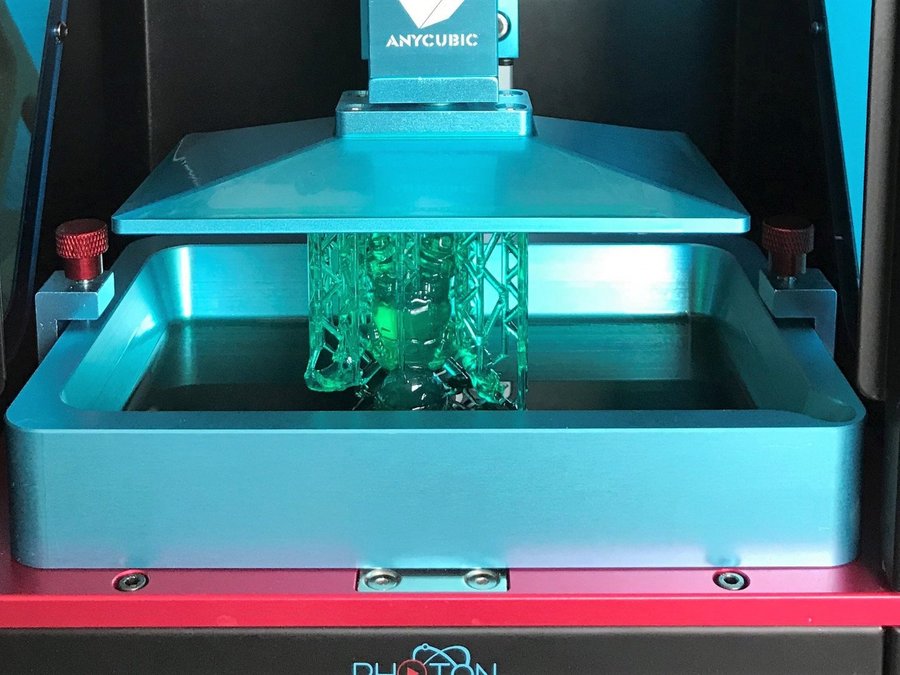SLA vs DLP
Much like SLA vs FDM, one of the other most popular 3D printing topics are the debate between SLA vs DLP 3D printers. Both use resins to form the objects and light to solidify the resin’s layers. The big difference between the two are the type of lights the 3D printers use.
To back it up, the 3D printer is a tool that creates rapid prototypes through resin or filaments. Subtractive manufacturing like laser cutting and metal bending takes away from metal to create parts, additive manufacturing builds parts from a 3D model.
Originally known as rapid prototyping, 3D printing is the process of building 3D solid objects from a digital file. G-code is the most common file format. This file contains coordinates to guide the printer’s movements to print the material. These coordinates guide the printer’s movements, both horizontally and vertically, through the x, y, and z axes.
How the SLA 3D Printer Works
The SLA 3D printer acts much differently than an FDM 3D printer. Unlike FDM printers that use filaments like thermoplastics to print the product from the base to the top, SLA dips the product upside down into the thermoset resin. The printer uses a laser at the bottom of the dish of resin. This light source uses G-Code from the 3D file to coordinate the exact position to permanently cure the resin one layer at a time.
Since it uses SLA to build layers, it takes a period of hours to turn 2D prints of a 3D CAD drawing into a three dimensional object. The 3D printer must dip over the same area of the resin bath in order to create all the necessary details for layering. SLA 3D printers have the highest resolution and accuracy, the sharpest details, and the smoothest surface finishes of all 3D printing technologies. Unlike thermoplastics, thermosets permanently mold after heating.
According to WoodlandPlastics.com, a thermoset monomer must have three or more reactive ends, with its molecular chains crosslinking in three dimensions. Post-molding, thermosets have virtually all molecules interconnected with strong, permanent, physical bonds which are not heat reversible. The SLA 3D printer uses laser UV light to meticulously hit every exact detail of the build.

SLA 3D Printer Thermoset
SLA printers can use many different resins which are thermosets. Thermoset plastics are are synthetic materials that strengthen when heated, but cannot successfully be remolded or reheated after initial heat-forming or molding. After thermosets are molded, the resulting parts offer protection against high operating temperatures, corrosion, and chemical resistance. With all that said, these are the different types of resins.
- Standard Resin
- Clear Resin
- Tough Resin
- Flexible Resin
- Water-Washable Resin
- Ceramic-Filled Resin
SLA Post-Processing
Once the object completely prints, it must go through a post-processing. The process can vary depending on the project. SLA printers require much more than FDM printers. They need to wash with a specific type of liquid, isopropyl alcohol (IPA) or tripropylene glycol monomethyl ether. This will help avoid the products from being sticky. The machinist can remove the structures after the product is clean.
The machinists use Ultraviolet curing (commonly known as UV curing) to dry the coatings. Ultraviolet curing is a photochemical process in which high-intensity ultraviolet light is used to instantly cure or “dry” inks, coatings or adhesives.
This creates a very smooth finish that has high quality measurements. These SLA parts have very high dimensional accuracy and intricate details.
SLA Industry Uses
Since SLA 3D printing is more popular than DLP 3D printing, it can be used in a variety of different industries. With many of the industries overlapping DLP 3D Printing, it very much depends on popularity. The industries that use SLA 3D printing are:
- Manufacturing
- Engineering
- Dental Applications
- Education
- Healthcare
- Entertainment
- Jewelry
- Audiology
Manufacturing
3D printing empowers engineers and product designers to rapidly produce and advance high-fidelity prototypes from ideas and realistic proofs of concept. These prototypes look and work like final products, and guide products through a series of validation stages toward mass production.
Engineering and Product Design
Much like the manufacturing industry, Manufacturers automate production processes and streamline workflows by prototyping tooling and directly 3D printing custom tools, molds, and manufacturing aids at far lower costs and lead times than with traditional manufacturing. This reduces manufacturing costs and defects, increases quality, speeds up assembly, and maximizes labor effectiveness.
Dental
Digital dentistry reduces the risks and uncertainties of human factors. This provides higher consistency, accuracy, and precision at every stage of the workflow to improve patient care. 3D printers can produce a range of high-quality custom products and appliances at low unit costs with superior fit and repeatable results.
Education
3D printers are multifunctional tools for immersive learning and advanced research. They can empower students to create and innovate, create a hands-on learning experience, improve problem solving kills, and leverage design thinking all while exposing students to professional-level technology.
Healthcare
Much like dentistry, healthcare is a field that has high value. SLA 3D printing helps doctors deliver treatments and devices customized to better serve each unique individual, opening the door to high-impact medical applications while saving organizations significant time and costs from the lab to the operating room.
Entertainment
High definition physical models are widely used in sculpting, character modeling, and prop making. 3D printed parts have starred in stop-motion films, video games, bespoke costumes, and even special effects for blockbuster movies.
Jewelry Applications
Jewelry professionals use CAD and 3D printing to rapidly prototype designs, fit clients, and produce large batches of ready-to-cast pieces. Digital tools allow for the creation of consistent, sharply detailed pieces without the tediousness and variability of wax carving.
Audiology
Hearing specialists and ear mold labs use digital workflows and 3D printing to manufacture higher quality custom ear products more consistently, and at higher volumes for applications like behind-the-ear hearing aids, hearing protection, and custom earplugs and earbuds.
How the DLP 3D Printer Works
Much like SLA 3D Printer, the DLP 3D printer dips the products upside down into the thermoset resin. Instead of using a laser to cure the resin, the printer uses a projector at the bottom of the dish of resin. This light source uses G-Code from the 3D file to coordinate the exact position to permanently cure the resin one layer at a time.
Since it uses DLP to build layers, it is much quicker than most 3D printers to turn 2D prints of a 3D CAD drawing into a three dimensional object. The 3D printer must dip over the same area of the resin bath in order to create all the necessary details for layering. DLP 3D printers have the highest resolution and accuracy, the sharpest details, and the smoothest surface finishes of all 3D printing technologies. Unlike thermoplastics, thermosets permanently mold after heating.
According to WoodlandPlastics.com, a thermoset monomer must have three or more reactive ends, with its molecular chains crosslinking in three dimensions. Post-molding, thermosets have virtually all molecules interconnected with strong, permanent, physical bonds which are not heat reversible. The DLP 3D printer uses projected UV light to meticulously hit every exact detail of the build.

DLP Post-Processing
Once the object completely prints, it must go through a post-processing. The process can vary depending on the project. DLP printers require much more than FDM printers. They need to wash with a specific type of liquid, isopropyl alcohol (IPA) or tripropylene glycol monomethyl ether. This will help avoid the products from being sticky. The machinist can remove the structures after the product is clean.
The machinists use Ultraviolet curing (commonly known as UV curing) to dry the coatings. Ultraviolet curing is a photochemical process in which high-intensity ultraviolet light is used to instantly cure or “dry” inks, coatings or adhesives.
This creates a very smooth finish that has high quality measurements. These DLP parts have very high dimensional accuracy and intricate details.
DLP Industry Uses
Unlike SLA 3D printing, DLP 3D printers have 3 main industries that use their resin models. This is due to the speed of larger projects that match customer demand. These are the three main industries:
- Dentistry Applications
- Jewelry
- Audiology
Dentistry Applications
Much like SLA, DLP is able to make dentistry models that include orthodontics, teeth molds, The first is in dentistry, which includes making models for use in orthodontics, teeth molds, and more.
Jewelry
The second industry that goes between SLA and DLP is the jewelry industry. They use DLP 3D Printers to make molds that create solid metal jewelry pieces. DLP’s ability to create detailed and intricate pieces is invaluable in this process.
Audiology
Lastly, DLP can create hearing aids. Hearings aids are one area where, despite its infancy, 3D printing has utterly taken over. DLP and SLA 3D printing make 98% of hearing aids . This is because people’s ears vary in shape and size and a custom sized hearing aid needs to be made for each patient, making 3D printing the most effective production method.
DLP 3D Printer Thermoset
Much like SLA 3D printers, DLP printers can use many of the same resins which are thermosets. These are the different types of resins.
- Standard Resin
- Clear Resin
- Tough Resin
- Flexible Resin
- Water-Washable Resin
- Ceramic-Filled Resin
SLA vs DLP Summary
Overall, SLA vs DLP is a common topic in the 3D printer industry. In SLA 3D printing, liquid resin is cured by a highly-precise laser to form each layer, which can achieve much finer details and is more reliable to repeatedly achieve high-quality results. Much like SLA, DLP 3D printers use light to cure the objects. Unlike SLA, DLP uses a projection. This projection is much more smoothly finished and powerful.
Each have their advantages and disadvantages. With DLP projectors, manufacturers need to deal with the non-uniform light distribution on the build plane and optical distortion of the lenses—meaning that pixels in the middle are not the same size or shape as pixels on the edges. SLA 3D printers use the same light source for every part of the print, which means it’s uniform by definition, but they still require extensive calibration to account for distortions.
Regarding speed, as the projector exposes each entire layer all at once, print speed in DLP 3D printing is uniform and depends only on the height of the build, whereas, SLA 3D printers draw out each part with a laser. As a rule of thumb, this results in SLA 3D printers being comparable or faster when printing small or medium-size single parts, while DLP 3D printers are faster to print large, fully dense prints, or builds with multiple parts that fill up much of the platform.
If you are in need of a service from either 3D printers types, you should consider Parts Badger. Our 3D printing service will get your parts printed in break-neck speed. Click here to request a quote for your next 3D printing job.
We Are Your Custom Online CNC Machine Shop
Parts Badger creates your exact designed product. We use Instant quoting and 24/7 manufacturing to get your products created and back to you very quickly. Our services include but are not limited to:
Our knowledgeable team of experts will work closely with you to create high-quality components fabricated to your unique specifications, regardless of complexity. Contact us or request your rapid quote today to work with us on your next project.


Recent Comments